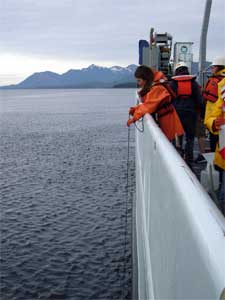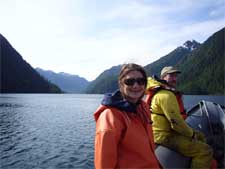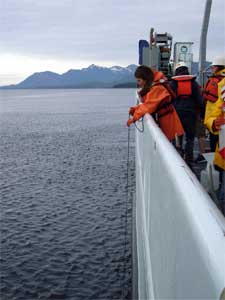 Baltimore native uses DNA fingerprinting to understand
Baltimore native uses DNA fingerprinting to understandimplications of global warming
KINGSTON, R.I. – November 13, 2007 – University of Rhode Island senior Melissa Mercier has gone scuba diving off Honduras, San Salvador, Bonaire, Cozumel and many other tropical locations, but it was her time on a month-long research cruise off the coast of Alaska last summer that generated the most excitement.
“The opportunity came up at the very last minute, and I was hesitant about going, but I’m happy I went because it was an amazing experience,” said the marine biology major from Baltimore, Md. “You can sit and listen in class, but when you’re sitting on a boat talking with scientists from all over the country, you learn a lot more. It just sticks with you.”
Mercier’s research expedition to Alaska, and a related cruise to the Sargasso Sea she participated in during spring break last March, was part of a National Science Foundation-funded study of the diversity and distribution of diatoms, single celled organisms found abundantly in every water body on Earth. 
“We’re doing DNA fingerprinting of the diatoms to compare those we found in the Sargasso Sea with those in Narragansett Bay and those in Japan and Alaska and elsewhere,” she explained. “We want to know how the same species may differ in different places.”
Working in collaboration with URI Professors Tatiana Rynearson and Bethany Jenkins, Mercier and a team of graduate and undergraduate students are trying to learn whether diatoms differ due to changing environmental conditions, which may have implications for understanding the effects of global warming.
Mercier and the other researchers worked in shifts around the clock collecting water samples, filtering out the diatoms, and storing them at –80 degrees.
“I spent a lot of time isolating single diatoms under the microscope,” she explained. “It’s helpful to get a good look at exactly what you’re working with so you have a better understanding of what you’re doing. I saw a lot of species in Alaska that we didn’t find in the Sargasso.”
During her down time on the cruise, Mercier played games and watched movies with the other student researchers. “They were a good group of people to hang out with,” she said.
She was also impressed with the abundant wildlife she saw in the waters around Alaska, including porpoises, sea lions, bald eagles, giant starfish, and the first whales she has ever seen. “And the scenery was amazing! The mountains were incredible and we saw beautiful sunsets,” she said.
But it wasn’t all fun. The research vessel was stuck in a three-day storm that forced the crew to shut down the ship due to the high seas. “The boat was really rocking and we got tossed around a lot trying to sleep,” Mercier said. “During those days we couldn’t do any work, everything had to be tied down, and it was hard to eat or to maneuver around on the boat.”
As the URI student enters her senior year, she is already looking to the future and planning for graduate school.
“I really like the genetic aspects of the research we’re doing, and the genetic techniques I’ve learned can be used with a lot of other organisms,” Mercier said. “Whatever I end up doing, I definitely want it to involve some kind of field research.”

